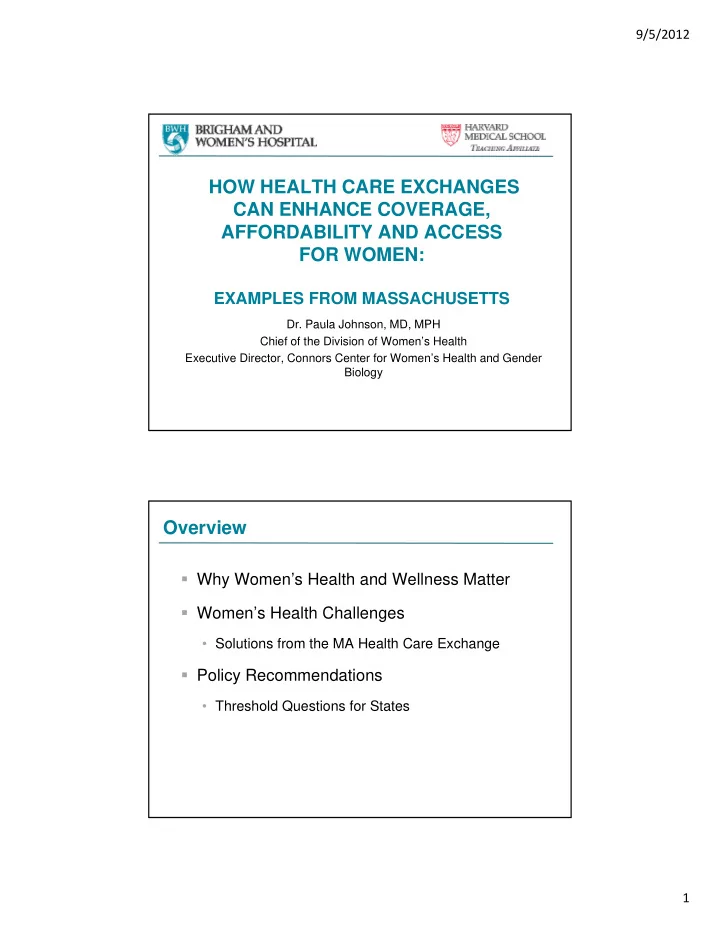

9/5/2012 HOW HEALTH CARE EXCHANGES CAN ENHANCE COVERAGE, AFFORDABILITY AND ACCESS FOR WOMEN: EXAMPLES FROM MASSACHUSETTS Dr. Paula Johnson, MD, MPH Dr Paula Johnson MD MPH Chief of the Division of Women’s Health Executive Director, Connors Center for Women’s Health and Gender Biology Overview Why Women’s Health and Wellness Matter Women’s Health Challenges • Solutions from the MA Health Care Exchange Policy Recommendations • Threshold Questions for States 1
9/5/2012 Why Women’s Health? Women’s health is a major determinant of the health of communities and future generations generations. Women: Have higher rates of chronic disease Utilize more medical services than men Have higher annual health care expenses Have higher annual health care expenses Face more challenges affording care Are more likely to have inconsistent insurance coverage Why is Women’s Wellness Important? The direct cost of women’s major chronic health conditions is estimated at $466 billion dollars per year in the U.S. Chronic diseases: Chronic diseases: Cause 7 of 10 deaths among Americans each year and account for 75% of the nation’s health spending. More than one in three of all women and more than ½ of women age 50-64 have a chronic condition that requires ongoing medical attention. African American women have higher rates of several chronic African American women have higher rates of several chronic conditions, compared to White and Latina women, including arthritis, hypertension, and heart disease. Preventive Services: In 2011, 54% of women were not up-to-date on their recommended preventive services. 2
9/5/2012 Women’s Health Challenges Transitions in coverage Affordability Access to primary care Data stratification Transitions in Coverage THE CHALLENGE : A significant number of low-income residents transition between Medicaid and subsidized insurance plans over p the course of the year due to changes in eligibility status. Women are disproportionately impacted by this coverage volatility or “churning”. 17% of MA residents who transitioned experienced a gap in coverage. In 2010, the administrative expenses associated with transitions cost Massachusetts over $46 million dollars. t M h tt $46 illi d ll MA Examples: Virtual Gateway Basic Health Plan 3
9/5/2012 Massachusetts's Vision for Expanding & Simplifying Coverage Options QHP = Qualified Health Plan BHP = Basic Health Plan Shopping for Unsubsidized Coverage 4
9/5/2012 Shopping for Unsubsidized Coverage: Preliminary Information Shopping for Unsubsidized Coverage: Choosing a Coverage Level 5
9/5/2012 Shopping for Unsubsidized Coverage: Comparing Plans Helping Residents Apply for Subsidized Coverage 6
9/5/2012 Helping Residents Apply for Subsidized Coverage Access to Primary Care THE CHALLENGE : Expanding health insurance coverage exacerbated existing shortages in key women’s health specialties: Primary Care Internal Medicine, Family Medicine, Obstetrics and Gynecology, and Mental Health. ACA Title V: Health Care Workforce: Dedicates more than $200 million to training primary care doctors, nurses, and physician assistants. , , p y Expands the National Health Service Corps program by $1.5 billion over five years. 7
9/5/2012 Access to Primary Care MA Examples: Public-private Partnership for Loan Forgiveness Primary care providers agree to work for up to three years in a f Massachusetts community health center in exchange for $25k in loan repayment per year. Through 7/1/12, 128 primary care providers have participated in the program creating capacity for more than 225,000 patients. Kraft Center for Leadership / Training Kraft Fellowship Program K ft F ll hi P Kraft Practitioner Program Health Care Workforce Center Established by MA health reform law, Chapter 305 of the Acts of 2008, Section 25L. Access to Primary Care New Patient Wait Times In Massachusetts, Selected Specialties: 2006-2011 60 52 53 50 46 48 46 44 44 44 50 36 41 r of Days 36 34 34 33 34 40 29 30 20 10 10 Number 0 2006 2007 2008 2009 2010 2011 Internal Medicine Family Medicine* OB/GYN 8
9/5/2012 Access to Primary Care % of MA Physicians accepting Family Internal OB/GYN new patients Medicine Medicine Rural (Franklin County) 17% 50% 0% Urban (Suffolk County) 50% 35% 75% Average wait times for new Family Internal OB/GYN patients in MA Medicine Medicine Rural (Franklin County) 205 days 52 days N/A* Urban (Suffolk County) 23 days 64 days 38 days •Not accepting new patients + Data for psychiatry/mental health is unavailable Data Stratification THE CHALLENGE : No specific commitment to stratifying critical health care reform indicators by sex and sex/race groups. reform indicators by sex and sex/race groups ACA § 4302 Requires standards for collection of self- reported data including sex and race/ethnicity and publically reporting data on these indicators to the extent practicable . MA Examples: MA Examples: National and local coalitions of stakeholders Amendment language MA Health Disparities Report Card Institutional Review Board (IRB) All Payers Claims Database (APCD) 9
9/5/2012 Data Stratification Transitions across MA Health Insurance Coverage Programs: Monthly Average Jan. 2008 – April 2009 CommCare: MA subsidized exchange plans HSN : Health Safety Net (free care) MassHealth : MA Medicaid Data Stratification Massachusetts Uninsured Tax Filers by Sex, 2009 (n=170,000) Unknown, 32% Male, 44% Female, 24% Source: Massachusetts Department of Revenue 10
9/5/2012 Policy Recommendations Threshold Questions for States Health Exchanges: 1 1. Comprehensive services for women across the lifespan Comprehensive services for women across the lifespan 2. Ensuring affordable and continuous coverage for women 3. Educating women on exchange benefits 4. Broad range of providers to meet women’s health needs 4 B d f id t t ’ h lth d 5. Assessing improvements in health care for women Contact Information The Women’s Health Policy and Advocacy Program Connors Center for Women’s Health and Gender Biology Brigham and Women’s Hospital 75 Francis Street Boston, MA 02155 (P):617-525-6770 (F) 617 264 5191 (F): 617-264-5191 www.brighamandwomens.org/womenspolicy 11
Recommend
More recommend